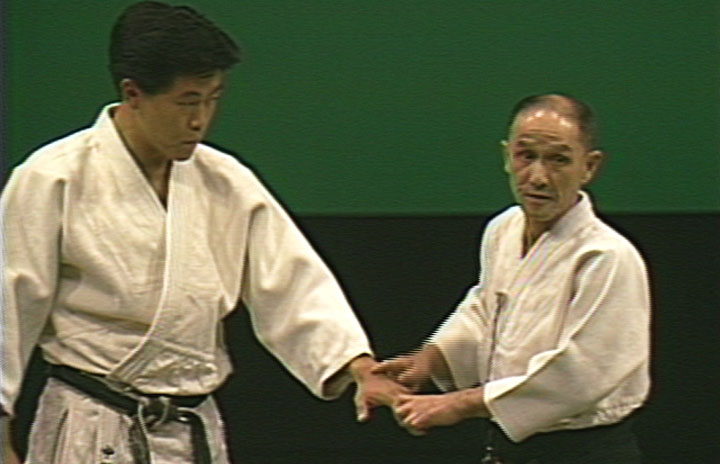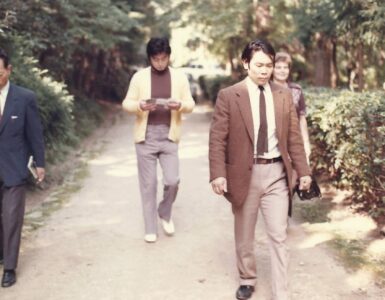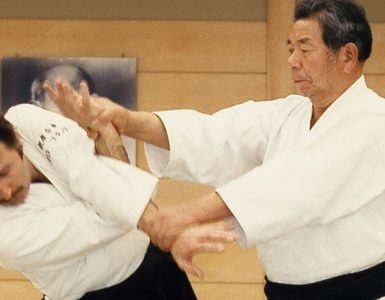This is part three of the series. Read the second part here.
Chapter Five: Aikido Basics
Basics are important for anything. Basics are important especially in aikido. I have repeated many times that it is not an exaggeration to say that basics are what aikido is all about. Allow me to talk about these basics.
(1) A Pure Heart
When practicing you have to put all other thoughts out of your mind and achieve a pure heart. You repeat each technique with an empty state of mind. Realizing this empty state of mind is more difficult than you might expect. Therefore, in the beginning, you must consciously make an effort to remove all other thoughts from your mind. The process is the same as realizing a spiritual state of perfect selflessness while sitting in meditation. Through repeated effort to achieve this empty state of mind, you will someday unconsciously realize this goal. It is then that you will have achieved a pure heart. As long as you are conscious of your purpose you have not yet reached this state. It may take quite some time to attain this goal. This is an important first step in your training. If basics are the essence of aikido, this can be regarded as the first stage of basics.
(02) Calmness In Movement
In Zen one pursues a state of calmness while inactive but in aikido we attempt to achieve this state in action. aikido techniques naturally include movements. Yet when moving, you should never loose a pure heart but always maintain a normal mental state.
In aikido you move in accordance with the movement of your opponent. You don’t go against his power but rather you draw his power into you. Sometimes you control your opponent just by leading his power or adding your own power to his which you have already absorbed.
If, during your movement, you lose your pure heart, you will lose sight of your opponent’s movement and the flow of his power. This will result in your clashing with him or mistiming your movement which will end up destroying the effectiveness of the technique. If you are more powerful than your opponent you may manage to pin him. However, you will have defeated him with force and not with aikido. Only when there is peace in your actions will you be able to see well your opponent’s movements and the flow of his power.
When practicing you have to put all other thoughts out of your mind and achieve a pure heart. You repeat each technique with an empty state of mind. Realizing this empty state of mind is more difficult than you might expect. Therefore, in the beginning, you must consciously make an effort to remove all other thoughts from your mind.
I often see situations where a person applying a technique on his partner thinks his technique is correct but fails to successfully execute it. This is because he is clashing with the movement or flow of the power of his partner at some point. A growing desire to defeat the opponent results in a loss of composure and the inability to see him with a pure mental state.
When I was a beginner a senior once grabbed my hand strongly and I had trouble trying to move in order to apply a technique. Ueshiba Sensei happened to see me struggling then and said to me: “Shioda, you ought to be able to do better than that. The reason you cannot move is because you are only paying attention to your hand and putting too much power into it. If you look at his eyes, you will see the whole and that will make it easier for you to apply a technique.” Indeed, I was only paying attention to my arm in trying to throw him. In other words, not only did I fail to see the flow of my opponent’s power but also my center of gravity had risen. I didn’t realize that my ability to concentrate, which can occur only when one’s whole body is united, was being disturbed.
I then realized the meaning of Ueshiba Sensei’s words, that is, if you see your opponent’s eyes with a pure heart it will help you to see him as a whole and to know the direction of the flow of his power. At the same time, you will see the reflection of yourself as a whole in him. Ever since then I have made it a rule to remember his words and the training goal they represent whenever I practice.
Sensei never taught techniques in a step-by-step way. He just told us to practice hard and also often told us to “learn techniques and forget them”. This means that you learn martial arts not with the brain but with the body. However, I believe there is something more important in his words. If you face your opponent with a pure heart, you will begin to see him and yourself very clearly. This pure heart refers to a proper mental attitude or psychological state before practicing techniques. We should also learn this important basic instinctively. Thus, even if your opponent is holding a weapon such as a knife, a sword or a stick or if there are many opponents, there is no need to become unsettled. Here is a relevant poem by Ueshiba Sensei:
When surrounded by a forest of spears, know that your spirit is your shield.
(3) When Facing An Enemy, Unite With Him
Kiichihogen, a legendary character is purported to have said the above words. aikido is a martial art where one unites his ki with his opponent’s. In other words, you don’t struggle against your opponent. If he pushes you, you don’t push him back. If he pulls you, don’t pull him back but rather harmonize with him. This too is one of the important basics of aikido. It goes without saying that you cannot harmonize yourself with your opponent without a pure heart as I mentioned earlier. Harmony is conformity, not compromise. Unification with your opponent creates a single flow of movement where there is no clashing. Therefore, you can apply a technique without using unnecessary force. This is why women, children and elderly people without physical strength can continue to practice aikido.
If, during your movement, you lose your pure heart, you will lose sight of your opponent’s movement and the flow of his power. This will result in your clashing with him or mistiming your movement which will end up destroying the effectiveness of the technique. If you are more powerful than your opponent you may manage to pin him. However, you will have defeated him with force and not with aikido. Only when there is peace in your actions will you be able to see well your opponent’s movements and the flow of his power.
Since aikido is not a martial art where you initiate an attack but rather an art of self-defense, you can harmonize yourself with your opponent according to how he approaches you. Because your opponent is preceded by his flow of power you can lead his movement into yours in order to apply a technique.
In this manner you and your opponent unite to create a single flow. Thus, when some people who don’t know aikido see a demonstration given by experienced practitioners they become suspicious of the art and believe that everything is prearranged. However, if they start aikido they will later come to realize that their impression of the art was incorrect.
In aikido demonstrations, the more advanced the persons executing the techniques and taking the falls are, the more balanced their minds, techniques and bodies become. As their “kokyu” or breathing becomes united, the artistic beauty of harmony emerges. This beauty is different from the elegant beauty of dancing or gymnastics. I would describe it as a “severe” beauty, that is, like an autumn frost.
It is my belief that if everyone were to absorb the basics of aikido, or in other words, “when confronted with an opponent, harmonized with him” and made this principle the basis of their lives, all conflict and strife would disappear. I will be pleased if readers understand that my dream is to make a contribution to the peace of mankind through this martial art of harmony, aikido, which originated out of a desire to achieve this ideal.
(4) Balances In The Body
The basics I mentioned in sections (1) to (3) can be considered as a mental preparation for aikido which should always be kept in mind. Metaphorically speaking, they can be said to represent a balance of mind. On the other hand, the balance of body I will talk about here involves the basics of body posture which will maximize the effectiveness of aikido techniques.
I then realized the meaning of Ueshiba Sensei’s words, that is, if you see your opponent’s eyes with a pure heart it will help you to see him as a whole and to know the direction of the flow of his power. At the same time, you will see the reflection of yourself as a whole in him. Ever since then I have made it a rule to remember his words and the training goal they represent whenever I practice.
The body is balanced when the toes, knees, hips and body are united to form a straight line like a large tree with its roots penetrating into the soil. This stability of balance together with the “kokyu” power I will mention later, is one of the essential elements for the strengthening of one’s power of concentration. We move our bodies frequently and rapidly when we execute techniques or shift positions. Thus it is important to be able to shift your balance whenever you move. It is moreover essential to maintain a stable position when shifting your balance in order to generate strong power. Yet this is quite difficult to do. Even if you are stable in your “kamae” or stance, you tend to break the straight line of your body when making your next movement. This results in a loss of balance or a rising of your center of gravity. Considerable study and training are required to accomplish this.
For example, we often see situations in which students tend not to feel much pain when “nikajo” is applied on them after they become more advanced. Watching those attempting to throw closely I have found several reasons for this. In most cases, they either clash with the flow of their partner’s power or their balance rises or both. In other words, they don’t maintain a balance of basics (1) through (4) mentioned thus far.
In boxing, punches are not effective if you hit your opponent solely with the power of your arms. They are effective when you punch using your hips. Here, also, it is a matter of balance.
Even if you succeed in keeping your balance, unless you catch the flow of your opponent’s power well and blend with it, the effectiveness of your technique will be reduced by half. Moreover, the flow of power of each opponent differs. So it is necessary to perceive it correctly in order to control your opponent. It is true that it is quite difficult even for experts to achieve this. There is no way other than learning it with your body through daily study and training.
(5) Timing
Timing is another of the basics. The four basics I have already referred to are of no use unless techniques are executed with proper timing.
For example, when a large stone falls from above, if you move away before the stone falls on your head you won’t be hurt. Applying this principle, when you are attacked by several people if you move about finding openings among them you can escape harm without touching them.
In this manner you and your opponent unite to create a single flow. Thus, when some people who don’t know aikido see a demonstration given by experienced practitioners they become suspicious of the art and believe that everything is prearranged. However, if they start aikido they will later come to realize that their impression of the art was incorrect.
If your timing is slow you will be controlled by your opponent. If you are too early he will know your next movement and be prepared for it. Thus your timing must be perfect.
Timing has various aspects. You time the flow of your power to harmonize with the flow of the power of the opponent attacking you. You time your movement to allow your opponent to push or pull you (without acting contrary to his pushing or pulling movement). You time your movement to evade your opponent’s attack or, on the contrary, to accept his attack. All of these constitute important basics for controlling your opponent.
You cannot become skilled at timing in a short period. When your movements are well-timed unconsciously as a result of daily practice the effectiveness of your timing will be displayed for the first time. When you consciously try to choose the timing, in most cases, you will not be successful.
One morning as usual I was out on my bicycle pulling my dog along on a leash. Since it was about 5:30 am and there were almost no people or cars in sight we were running quite fast. Then at a small intersection a car suddenly pulled out. The driver too was attempting to negotiate the road at a high speed. The pedal of my bicycle ran against some part of the car. The moment I sensed danger I let go of the dog’s leash and, kicking my bicycle to the right, I jumped on the hood of the car. My timing was just right and I acted unconsciously. I narrowly escaped injury. Whenever I remember this incident I am reminded how I emerged unscathed because of aikido and I feel grateful to Mr. Abe, the headmaster of the old 6th Junior High School and my father who encouraged me to begin training.













Add comment